1 West Lake
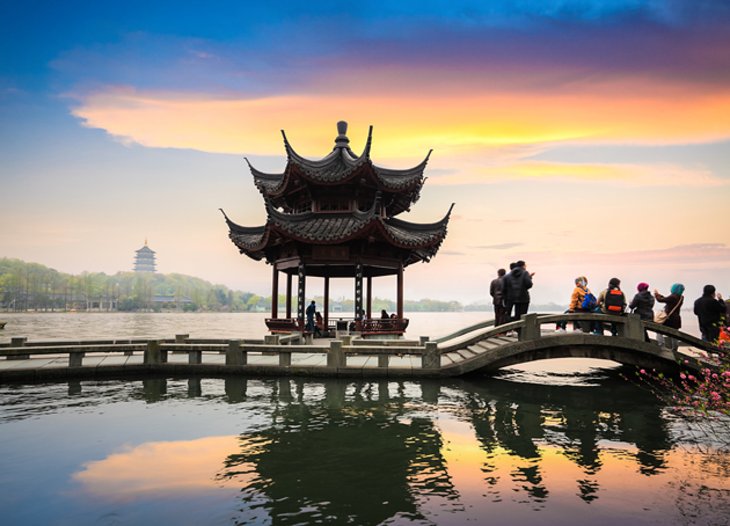
West Lake
The focal point of a visit to Hangzhou is beautiful West Lake around which much of the oldest part of the city is centered. Surrounded by hills and old temples, this large lake covers an area of nearly six square kilometers and is divided into five sections by the Su and Baidi Causeways: the Outer Lake (Wai Hu), the North Inner Lake (Beili Hu), the West Inner Lake (Xili Hu), the South Lake (Xiaonan Hu), and Lake Yue (Yue Hu). The nearly three-kilometer-long Su Causeway was built in 1089 and is itself one of West Lake's most important attractions, linking its north and south banks and tremendously popular for strolls, particularly in spring when its flowerbeds and peach trees are in bloom. It's also home to many fine old bridges, most notably the Broken Bridge (Duanqiao) linking the Baidi Causeway with the shore. Other highlights are the Pavilion of the Autumn Moon (Pinghu Qiuyue) from 1699, and the Pavilion of the Cranes built around 1300 in honor of poet Lin Hejing who died in 1028 and whose grave lies near the pavilion. Also worth visiting are the Isle of the Hill of Solitude(Gushan) with its fine views and museums; Little Paradise Island with its four mini-lakes linked by the zigzagging Bridge of the Nine Arches and famous for its lotus blossoms, water lilies, pavilions, and terraces; and the Bay of Flowers (Huagang), a 50-acre park dating back to the 12th century.
2 Home of the General: Yue Fei Temple
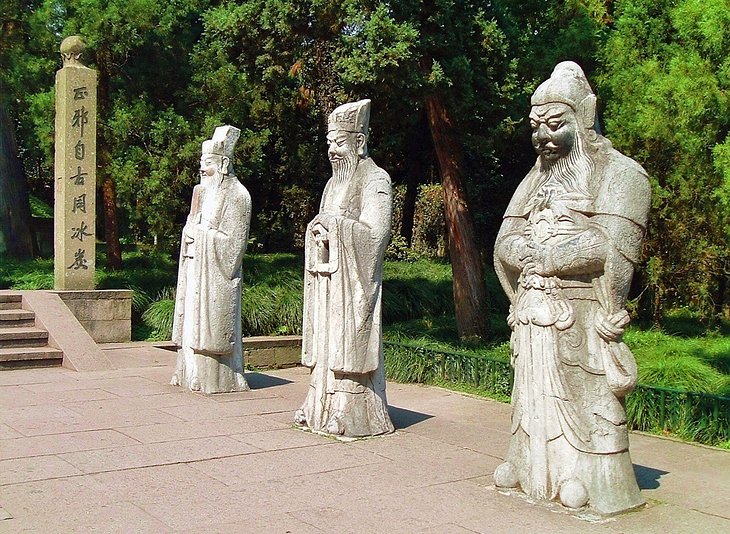
Home of the General: Yue Fei Temple
If you're only able to visit one of the many fine architectural structures on West Lake, make sure its Yue Fei Temple (Yuewang Temple). At the northern end of the Su Causeway, this splendid old temple was built in 1221 in honor of the much-revered General Yue Fei. Despite having successfully repelled several Tartar raids, he was falsely accused of high treason and along with his son was hung in 1142. Later he was cleared of the charges and reburied on the site of the temple built in his name. Highlights of a visit include a statue of Yue Fei in the Temple Hall, the ceiling of which is richly decorated with cranes, a symbol of immortality. The temple also contains 86 stone plaques on which Emperor Gaozong and his wife engraved classical texts by Confucius, while the most valuable treasure is a stone celestial globe dating from the time of the Five Dynasties (907-960). Also worth a visit is the nearby 500-acre Hangzhou Botanical Gardens with 4,000 species of plants, a splendid herb garden, and numerous different kinds of bamboo.
3 A City of Pretty Pagodas: Liuhe, Leifeng, and Baochu
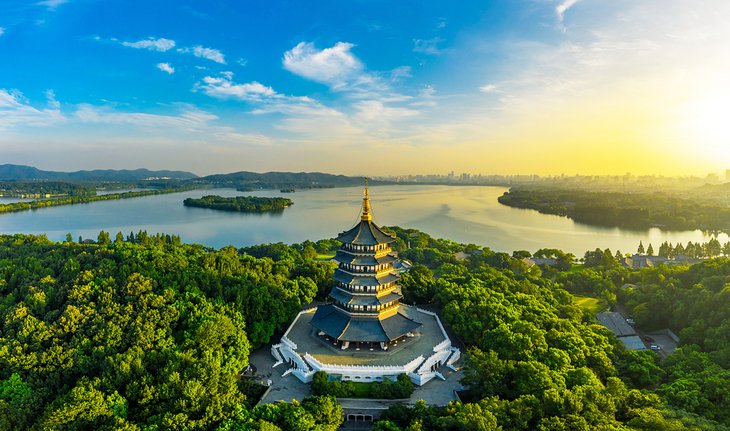
A City of Pretty Pagodas: Liuhe, Leifeng, and Baochu
Just eight kilometers south of Hangzhou on the north bank of the Qiantang River, the exquisite 60-meter high Pagoda of the Six Harmonies is well worth making the short commute for a visit. Tracing its roots back as far as 970 AD to the former pagoda, believed to have stood 150 meters tall and to have served as a lighthouse, the present structure was built in 1899 with the original ancient brick core retained and covered in wood cladding (also of interest are the many replicas of other pagodas from across China). A climb to the top of the building, accessible via a staircase, is well worth the effort for its superb views over the Qiantang River and its 1,322-meter road-and-rail bridge built in 1937. Also worth a visit is the city's Leifeng Pagoda (Léi Fēng Tǎ), a splendid five-story octagonal tower overlooking West Lake that dates from 975 AD, and the ancient stone Baochu Pagoda perched atop Precious Stone Hill.
4 Lingyin Temple and The Peak that Flew from Afar
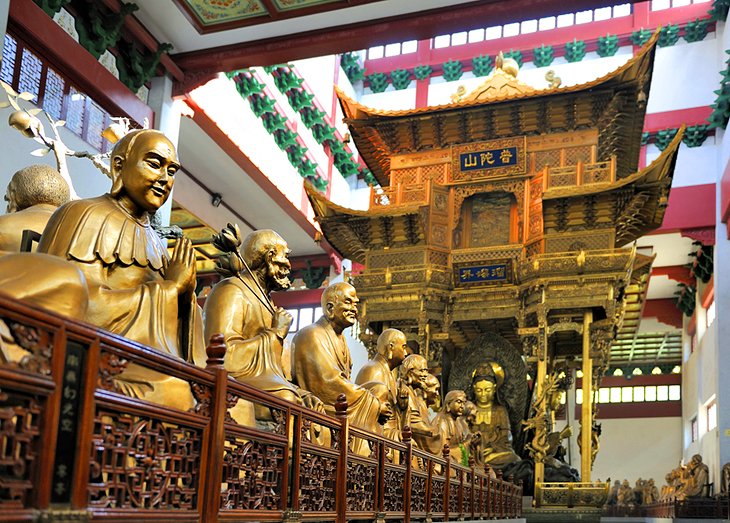
Lingyin Temple and The Peak that Flew from Afar
Another of Hangzhou's many splendid historic sites is the Lingyin Temple (Língyǐn Sì), the Temple of the Soul's Retreat, dating from 326 BC and one of the most famous Buddhist monasteries in China. Highlights include the Hall of the Celestial Kings with its many fine 12th-century sculptures, including those of the Four Celestial Kings, and the 34-meter-high Sumptuous Hall of the Great Hero (Daxiong Baodian), famous among pilgrims for its 20-meter-tall gilded statue of Buddha made of 24 pieces of camphor wood. Also notable here is The Peak That Flew from Afar (Feilai Feng), a mountain riddled with numerous caves and niches, the latter containing 380 Buddha statues dating from the 10th century, including the three oldest examples dating from 951 AD and found in the east wall of the Qinglin Cave. To the north of the Temple of the Soul's Retreat is the North Peak (Beigao Feng) with its superb views of West Lake and the surrounding scenery.
Address: Zhejiang, Hangzhou, Xihu
5 Longjing Tea and the Dragon Well
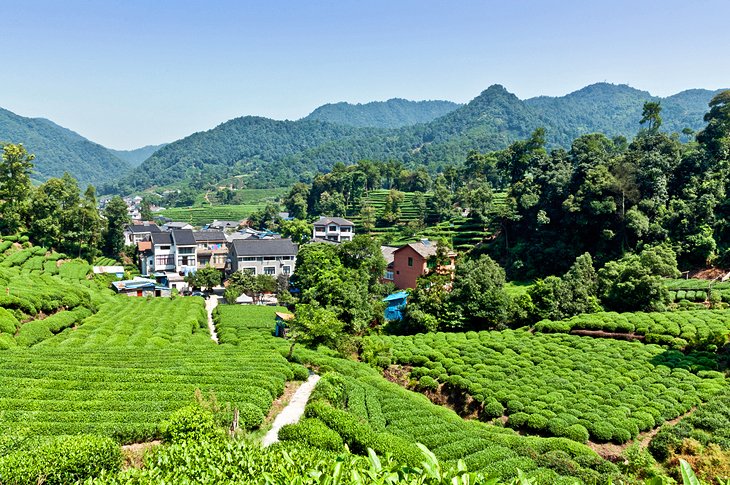
Longjing Tea and the Dragon Well
Hangzhou is famous the world over for its local Longjing tea (lóngjǐng chá), named after the small village just three kilometers southwest of West Lake where it's grown. The picturesque village of Longjing - literally translated as Dragon Well - sits amid some of China's most beautiful countryside and is easily accessible from Hangzhou. A highlight of a visit to the village and its many plantations is the chance to sample its traditional teas at source, the unique flavor of which is credited as coming from the ancient spring, which provides water for the village's well, the Dragon Well. Tours take in one of the tea factories in which the fresh tea leaves are refined, processed, and packed, as well as the superb China National Tea Museum, highlights of which are numerous exhibitions related to the production of tea as well the many ceremonies surrounding its consumption.
Address: 88 Longjing Rd, Xihu, Hangzhou, Zhejiang
6 Qinghefang Ancient Street
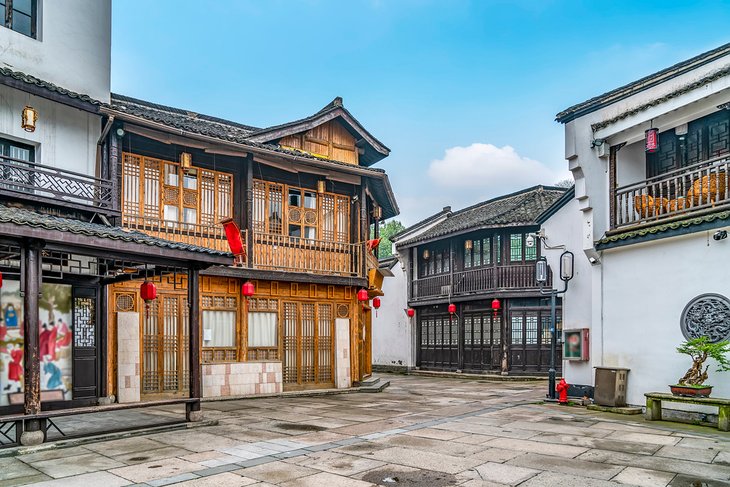
Qinghefang Ancient Street
When visiting Hangzhou, be sure to allocate at least a few hours to wander the city's splendid historic district centering on Qinghefang Ancient Street (qīng hé fāng gǔ jiē). An easy walk from West Lake, this always bustling and relatively unspoiled area provides a glimpse into what city life in China must have been like in the old days. In addition to its many traditional restaurants and teahouses, the area is a hotbed of creative culture with countless street artists demonstrating ancient writing skills and art techniques, along with boutique stores and market stalls selling everything from silk products to tea (Longjing, of course). Be sure to take a peek into some of the many unchanged side alleys leading off Qinghefang for a look at how Chinese tradesmen and craftsmen have lived through the centuries.
7 The Chinese National Silk Museum
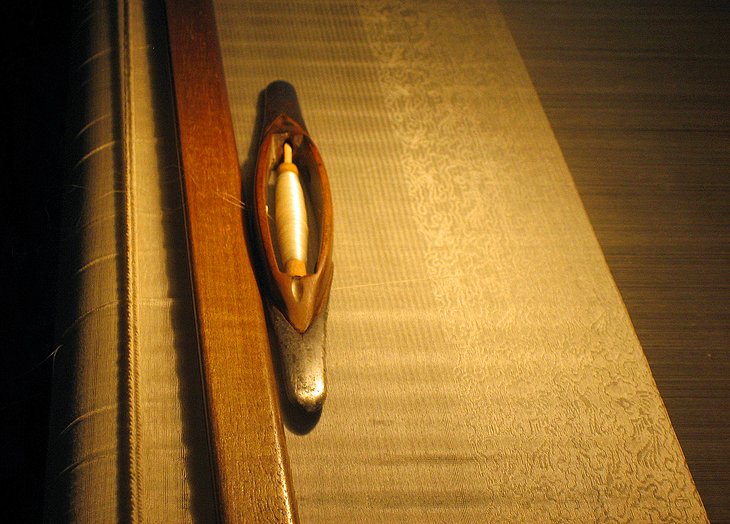
The Chinese National Silk Museum
Hangzhou's famous silk is celebrated across the city in its many markets and stores, as well as its cultural and arts facilities. However, the best place to learn more about this ancient industry's impact on the city is the superb Chinese National Silk Museum. Just a short hike from West Lake, this world-class facility - the largest of its kind in the world - offers a number of fascinating displays on the history of the country's most important textile through the centuries, covering everything from its manufacture to the many products made from it. Highlights are the numerous silk relics, including works of art and clothing, as well as exhibits on silk's importance as an item of trade and the famous Silk Road.
Address: 73-1 Yuhuangshan Rd, Xihu, Hangzhou, Zhejiang
8 Magnificent Mount Mogan
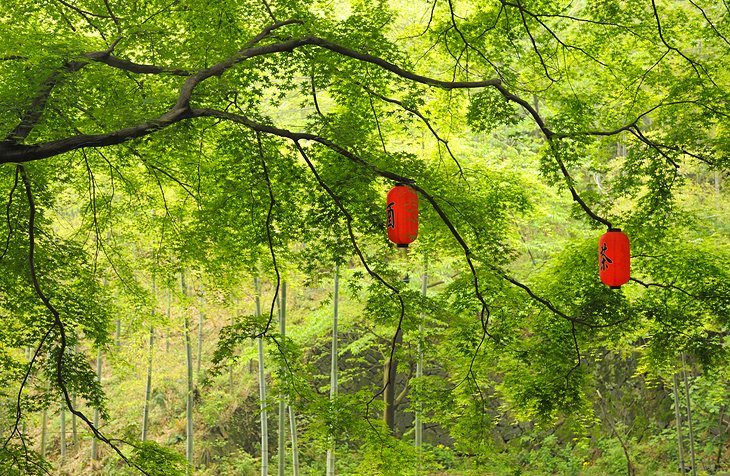
Magnificent Mount Mogan
One of the best excursions from Hangzhou (and easily accessible by public transit and tour buses) is to Mount Mogan (Mògànshān), a 719-meter-tall mountain about 50 kilometers northwest of the city. Taking its name from a legendary couple who lived here in the 5th-century BC - both gifted blacksmiths who devoted their lives to making two incomparably beautiful swords for the emperor - it's highly regarded for its outstanding natural beauty and has long been a favorite retreat for the country's social elite (Chiang Kai-shek had a place here). In addition to sightseeing, other popular activities include hiking and biking, with many stopovers at quaint local inns or smaller hotels set up in some of the older villas built in the early 20th century. A good jumping off point is the small town of Moganshan, home to many traditional restaurants and contemporary lodging options.
9 Wūzhèn Water Village
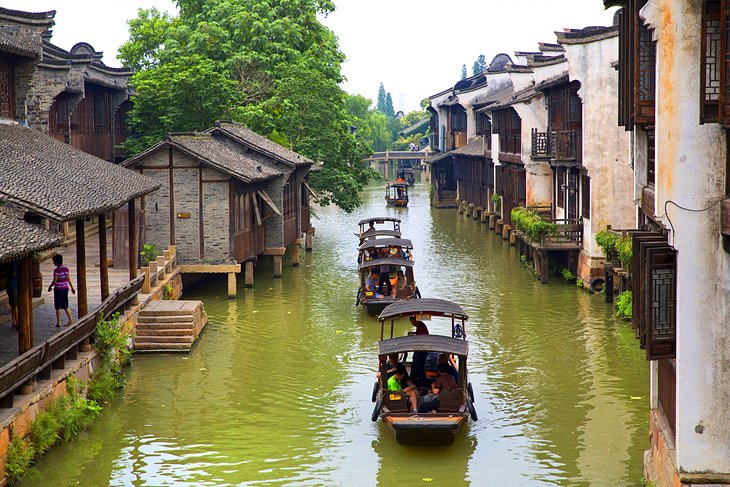
Wūzhèn Water Village
An hour's commute northeast of Hangzhou is Wūzhèn, one of China's most famous "water villages." Like a much smaller version of Venice, Wūzhèn is crisscrossed with waterways both wide and narrow, each bustling with long boats steered by locals punting along the water with large poles and carrying everything from vegetables to livestock to tourists. This popular tourist destination is split into six unique districts, each focusing on a particular facet of the area's rich culture, including those dedicated to crafts and workshops, traditional housing, food and drink, arts and entertainment, as well a shopping district. Exploring the town is easy thanks to a variety of well-marked routes leading to whatever particular area most interests you, and it's easy to spend hours wandering its many paths and bridges (be sure to partake in a boat ride). The town's most popular crossings are the Tongji and the Renji Bridges, famous as either can be viewed through the other's arch.
10 Running Tiger Spring
Also known by the romantic name of Dreaming of the Tiger Spring, Running Tiger Spring (Hǔpáomèngquán) is just five kilometers south of West Lake and is one of China's best-known springs. Legend has it that the spring was discovered by a monk around 819 AD who, during a time of drought, dreamed he would be led to a source of water by two tigers. To celebrate the discovery, a number of fine statues of tigers have been built overlooking the springs and its curative mineral waters that flow at an impressive 80 gallons per second (it's also famous for enhancing the flavor of locally grown Longjing tea, served in a nearby teahouse and across the region). Note that the surface tension of the water is unusually high and can be tested by placing a small coin on the surface and watching it float.
Address: 39 Hupao Rd, Xihu, Hangzhou, Zhejiang

No comments:
Post a Comment